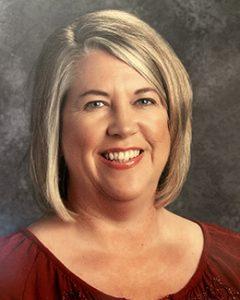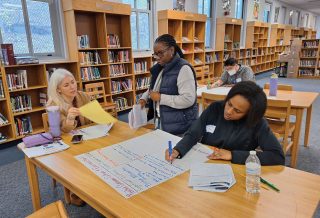DISTRICT MEMBER SPOTLIGHT
Missouri district weaves equity standards into professional learning
By Janet Crews
Categories: Evaluation & impact, Learning communities, Reaching all students, System leadershipApril 2024
“Drive” is one word Janet Crews uses to characterize the educators and students in the School District of Clayton in Missouri, where she works as an instructional coach and the coordinator of professional development. After 25 years in the district, Crews is very familiar with its values and culture. An enduring core value is a commitment to high-quality educator professional learning, which Crews fortifies with a Learning Forward district membership.
Crews’ district is situated just west of the city of St. Louis, Missouri, serving about 2,500 students. It draws excellent teachers because of its high-performing reputation and the value placed on professional learning. Crews spoke with us about the district’s professional learning initiatives and the resources she considers to be vital to her work.
What are some of your district’s big-picture professional learning goals?
This year, all school professional learning goals are connected to each other and the district strategic plan: empowered learning, social-emotional learning, and equitable learning. We also have additional literacy and math goals. The professional learning is interdisciplinary, and we’re all on the same page in a lot of ways, which is awesome.
How does your district use data to pursue your goals?
Our state asks us to do a needs assessment biannually, so we used the SAI (Standards Assessment Inventory) from Learning Forward. We were excited the SAI was included in the district membership, which was one of the reasons why we became district members. Our high school goes through an accreditation process, and we use SAI data to point to specific things that were celebrations since the last time (it was administered). I’ll share the data and report results with the board to show big-picture places we’ve grown. We are eager to see the new SAI data, especially because there are so many new equity pieces built in. That’s another data point that aligns with the equity work we’ve been doing.
Discover how @ClaytonSchools gathers professional learning outcome data from walk-throughs, the Standards Assessment Inventory (SAI), and more. SAI data are used for highlighting celebrations and district #equity alignment.… Share on XWhat are some of your equity work areas of focus?
Our most recent classroom walk-throughs focused on equity and have three areas: environment and classroom culture, what the teacher is doing to provide an inclusive experience, and how students are engaging with the teacher and one another. We have descriptors under each of those areas of what to look for because we’ve been doing professional learning related to all of those. (We want teachers to ask), What am I doing to know my kids so their identities are reflected in the text, the materials, and the examples I’m using? I love how all three (frames of the Standards for Professional Learning) have an equity component because it’s an equitable lens in every aspect of the work.
How do you conduct classroom walk-throughs to gather data?
What we call blast walk-throughs happen everywhere on one day. They are a great tool, kind of like learning walks. We go into the classroom a month or two (after the professional learning) to see if it’s actually getting into practice. We say, OK, if we’re looking at empowered learning, then what practices will we see? How do we collect that data? We collaboratively develop the tool and share it so teachers know what we’re looking for.
Our professional learning is embedded in so many places it can be challenging to parse out. How do you look for disparate pieces but also the bigger philosophy? Each time we do it, the data informs us. What are we going to do the next time? It’s a cyclical process. We look for celebrations, what we’re wondering, and potential next steps. We communicate that to staff — all anonymously, as patterns and themes — to say here’s what we saw. We’re excited to be able to have this common experience.
Can you elaborate on linking student achievement and outcomes to your professional development initiatives?
That’s often tricky because professional learning is embedded in so many places. Even when we did our own literature review, if you’re implementing professional development on a specific content area, like literacy or math, that’s an easier connection between professional learning and student outcomes. Our professional learning goals are empowered learning, social-emotional learning, and equitable learning, which are pervasive in all areas. Much of our professional learning is interdisciplinary because it’s focused on pedagogy. That’s where the blast walk-throughs have been such a great tool because we’re looking in the classroom. It’s us saying, “OK, if I implemented professional learning on empowered learning, then what practices will we see in classrooms? We initially identified five elements of empowered learning … and those were the things we looked for in the classrooms. A challenge has been a misunderstanding among some teachers that if I was doing these five specific things, then I was teaching empowered learning or in an empowered way for kids. Our principals pointed out you could have all of those elements and it still might not be a cohesive empowered experience for kids. This challenge provided opportunities for us to have great conversations about implementation.
How do you report your progress to the board? What do parents want to know?
We’re trying to keep to a bigger picture with our board (vs. getting into specifics) — really just, “Here’s the professional learning that’s been happening, here are some numbers around what we’ve spent, and here’s what’s happening as a result.” I rely heavily on Learning Forward for language. I always want to share the “why”: This is why we do this, what we believe, and therefore these are the things we did as a result. Then share the data we have and open it up for questions. We will be sharing results (from the SAI) with the board in April, which includes: Here are places we’ve grown, here are things we’ve done, and here’s what the results say in terms of teacher feedback.
For parents, so much of it is about the schedule. To them, professional learning means, “I have to figure out what to do with my kids.” Almost every month, we have a professional learning event, and we have gotten away from early release because parents didn’t love that. We’re very responsive to our parent community.
But parents do want to know, “What are you guys doing on professional learning days?” We’ve been trying to think about how we communicate what we’re learning and doing. We’re doing more interview clips with teachers saying, “Here’s what I worked on during a professional development day, and here’s how it’s benefiting my students.” Those little sound bites are effective in helping parents understand what we’re doing.
Download the PDF here.

Janet Crews (janetcrews@claytonschools.net) is the coordinator of professional learning for the School District of Clayton and a trainer for Cognitive Coaching and Adaptive Schools.
Categories: Evaluation & impact, Learning communities, Reaching all students, System leadership
Recent Issues
LEARNING DESIGNS
February 2025
How we learn influences what we learn. This issue shares essential...
BUILDING BRIDGES
December 2024
Students benefit when educators bridge the continuum of professional...
CURRICULUM-BASED PROFESSIONAL LEARNING
October 2024
High-quality curriculum requires skilled educators to put it into...
LEARNING TO PIVOT
August 2024
Sometimes new information and situations call for major change. This issue...












